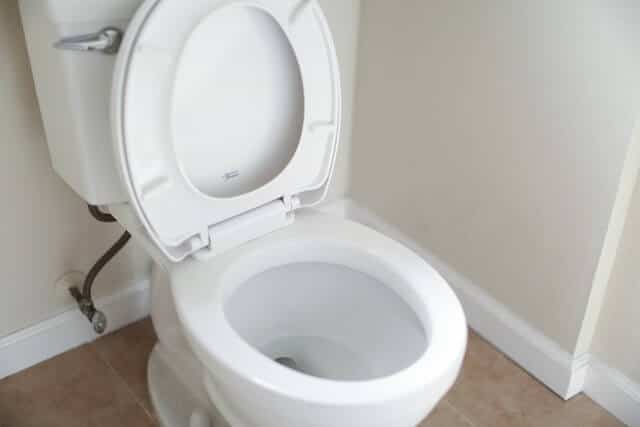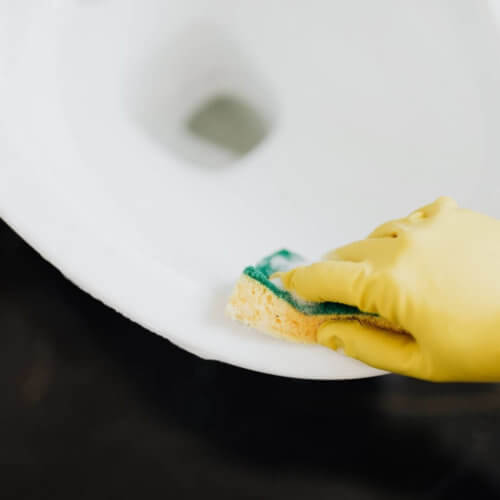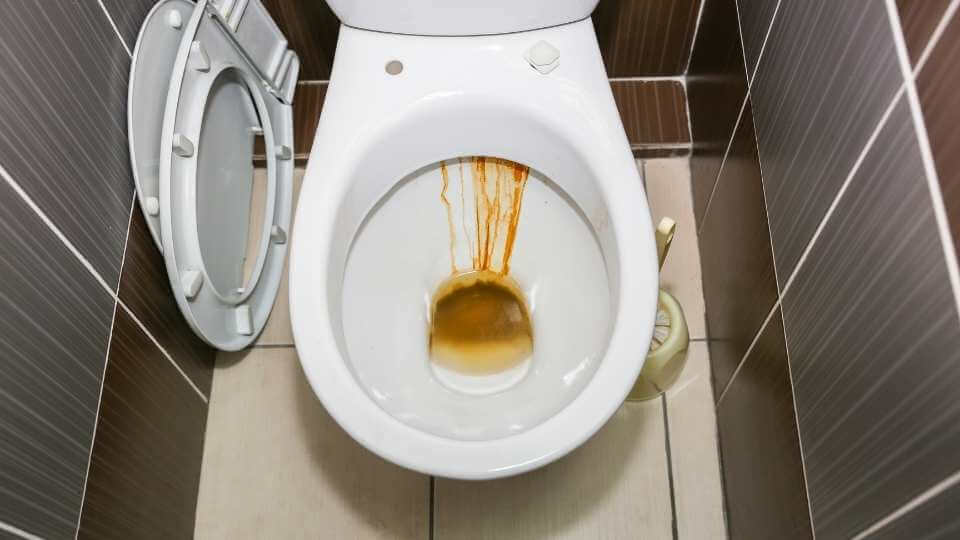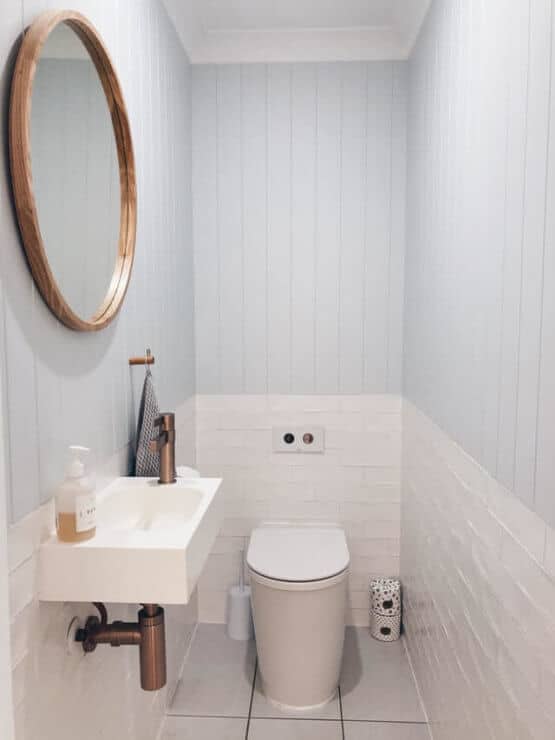Why is my toilet water red? This question may be not so rare nowadays. When it comes to toilets, maintaining these fixtures clean and sanitized is a common concern. Especially when you notice that water in the toilet bowl has an unusual color, you are prompted to make some research.
Toilet water can have different colors, such as blue, green, black, yellow, or red. Each color indicates a different problem.
In this article we will be looking at the main reasons why toilet water turns red. One situation is harmless for human health, the other can pose a risk if your immune system is weak.
Keep on reading to find out more, including how to get rid of red ring in toilet.
So Why is My Toilet Water Red?

Do you want to know how to get rid of red ring in toilet? First of all, you need to know what causes it.
There are two large causes of red toilet water:
- High levels of iron in your tap water
Rusting is a chemical reaction occurring when iron and oxygen come in contact with water. This can happen when you use older pipes made from galvanized steel. Once the protective layer of zinc wears of, rust begins to develop. [1]
This can be the case if water in your toilet is an orange-brown kind of red. The cause is rust, or iron oxide.
To be sure the cause of the problem is rust, turn on all the other water taps in your home. If tap water is the same color, then you have found your culprit.
Next, the rust in your tap water can come wither from the municipal water source or from your pipes. If your home has plastic pipes made from PVC or PEX, the rust probably comes from the municipal water source.
In the last case, the problem can be caused by the main water supply line bringing water into your house. Or the rust can come from a smaller pipe that feeds one or more of your water appliances.
Another cause of rust in water is using a private groundwater source such as a well. Iron from surrounding soil can seep in, causing your well water to have an orange-brown color. If you are using that water in your home, then toilet water turns red as well.
- Serratia marcescens
Serratia marcescens in toilet is a common occurrence, causing a red ring in toilet or red toilet water. The difference between rust and this bacterium is that Serratia marcescens has a red-pink color. This makes it easy to identify the cause of the red toilet water.
If rust in your tap water is not a huge health concern, the other cause of red toilet ring can represent a problem.
The slimy pink substance forming in toilet bowls and other damp areas in your bathroom needs certain conditions to thrive.
Serratia marcescens will grow in moist places where fatty substances accumulate. Such substances are soap residue in bath tubs and sinks and human waste in toilets.
You may also notice it in pet water dishes that have been contaminated with food residue. It has even been found on contact lenses!
But is this bacterium dangerous to human health?
According to health experts, Serratia marcescens does not pose health risks to healthy individuals. For a long time, this species of bacteria has been considered a harmless microorganism.
Serratia marcescens was first discovered in Italy at the beginning of the 19th century. Corn flour became red during an unusually humid summer, as the bacteria also like starch and can thrive in food. The red pigment it produces, called prodigiosin, is probably responsible for so-called miracles such as bleeding statues or “bleeding bread”.
While Serratia marcescens does not represent an issue for healthy people, it can become deadly in hospital environments. Those with a severely compromised immune system have a good reason to fear this pathogen. It’s possible for the bacterium to enter the body through a medical device such as a catheter.
Moreover, having comorbidities can make you more susceptible to disease caused by this pathogen.
Diseases caused by Serratia marcescens include:
- Pneumonia
- Urinary tract infection
- Bacteremia
- Biliary tract infection
- Wound infection
- Meningitis
- Endocarditis
If you notice red-pink staining on your shower wall or toilet bowl, don’t panic. Best is to remove it using chlorine, but at the same time get used to the idea that bacteria is everywhere. Serratia marcescens happens to be visible with the naked eye and cause problems in healthcare facilities.
How to get rid of red ring in toilet?

Do you suspect having Serratia marcescens in toilet bowl?
We already explain how the toilet ring is formed. In this section you will find out how to get rid of red ring in toilet and how to prevent it.
A very effective and simple solution is using bleach. Bleach can be used as it is or in various cleaning products. Use bleach to clean the red stuff from your toilet and other areas, but be careful about some common cleaning mistakes:
- Putting bleach in your toilet tank
Using bleach in your toilet tank can ruin the metal and rubber parts of the toilet and cause leaks around tank. Drop-in toilet tablets used to deodorize your toilet are also known to cause malfunctions in toilets. The best is to use cleaning products inside the toilet bowl only.
- Scrubbing dirt with a metal scrubber
Do you think that a metal scrubber will do a better job at cleaning your toilet bowl? This is a huge mistake. Metal scrubbers ruin porcelain finish and create tiny scratches and crevices, where bacteria such as Serratia marcescens love to hide.
- Cleaning just your toilet bowl
If you have Serratia marcescens in toilet, chances are the bacteria is located in other areas of your home, too. Look for it in your bathtub, shower cabin, sinks, and hidden places around the bathroom and kitchen. The more you remove of this bacterium, the smaller the chance it will reappear.
Cleaning just a small portion means the bacteria will easily migrate back to where you removed it. Pay special attention to the underside of the toilet rim, as bacteria is certainly hidden there.
What about rust?

But let’s not focus just on Serratia marcescens and remember that red ring in toilet can also be caused by rust. In this case, no matter how often you clean the toilet, the red ring will come back. This is because the cause has not been eliminated and running water still contains too much iron.
First contact a reliable plumber to test your water’s iron levels or get a home test. If the test indicates high concentrations of irons, it’s time to find out what causes them.
If the water itself is high in iron, you can use chemical treatments or water filters to remove the rust. Most drinking water filters are able to eliminate iron. There is also the possibility of using a filter specially designed to remove iron from well water. This is recommended when you use water from your own well.
Such filters have been created to solve issues like red toilet ring. More importantly, well water filters prevent stained clothes and appliances, clogged pipes, and toxicity risk.
If you are not using well water and water from your municipal source is good, the only remaining cause is rusty pipes.
This issue is prevalent in older homes, using old steel pipes. In this case, you will have to replace them with newer, rust-resistant pipe materials such as PVC or PEX. This operation can be expensive and disrupting, but not doing it can cause even more harm.
You will possibly be dealing with stained appliances and clothing, health issues, and burst pipes.
As steel pipes start rusting after 40-50 years of use, they can gradually become more and more degraded. Eventually, they can burst and flood your home. The cost of repairs and replacing damaged items can be higher than the cost of upgrading your old plumbing system.
End Line – Why is my toilet water red?
There are two answers to this question. There is either rust in your running water or your bathroom is contaminated with Serratia marcescens. No matter what causes this issue, red toilet water is just a symptom and the underlying cause can be much bigger. Our recommendation is to investigate the problem. Worst case scenario, you can deal with a flooded house.

Michael Davis is a heating & plumbing expert who currently works as independent contractor in SC. He also writes for Plumbertip.
For almost 10 years he worked on various plumbing tasks across South Carolina.


